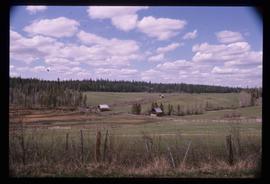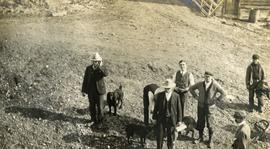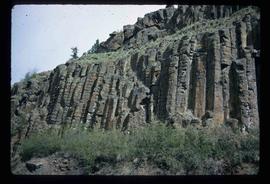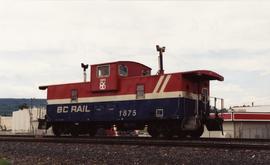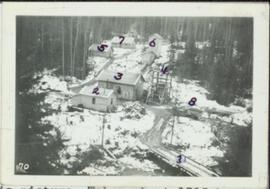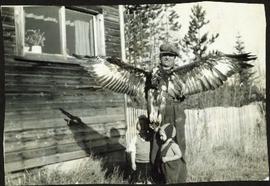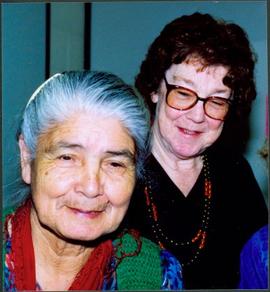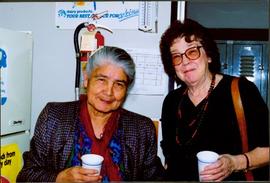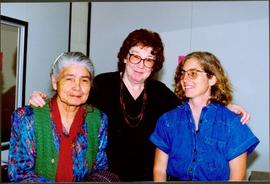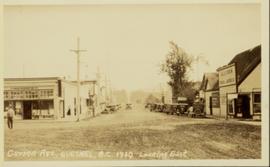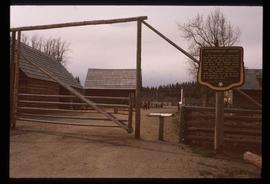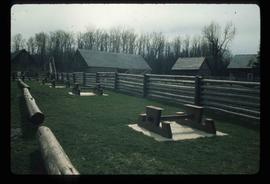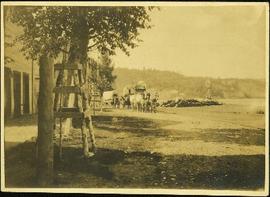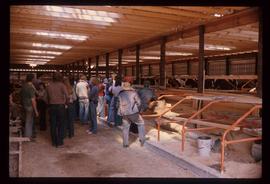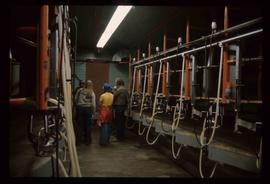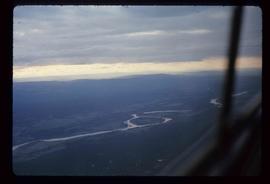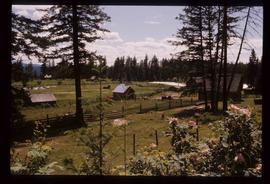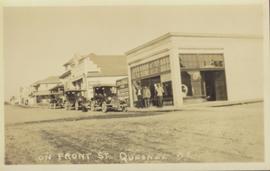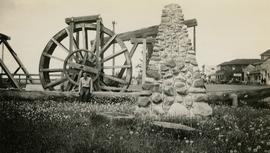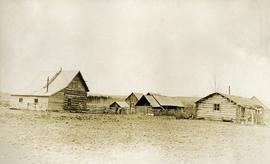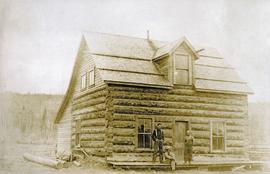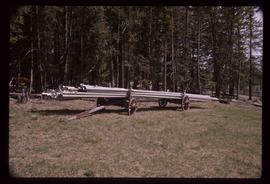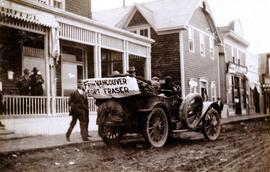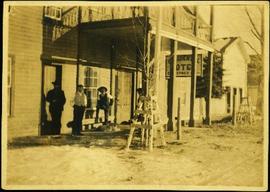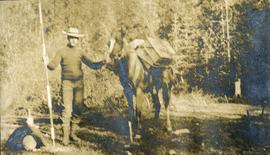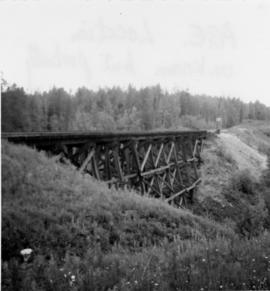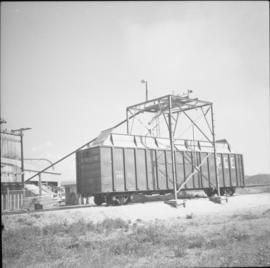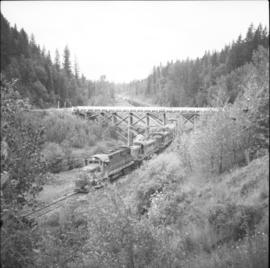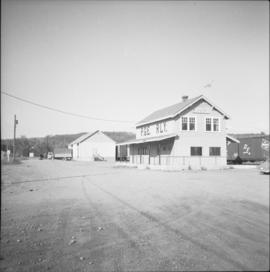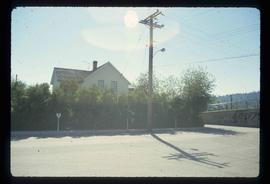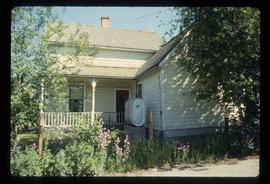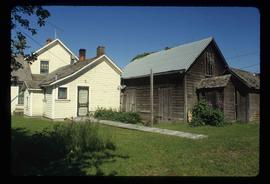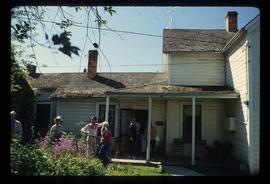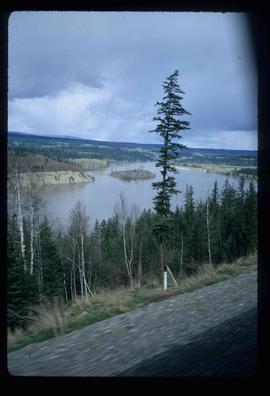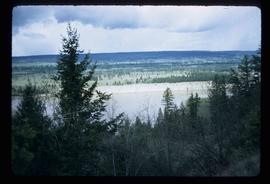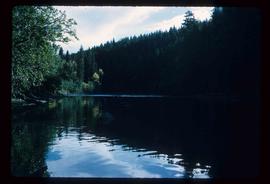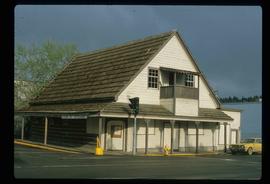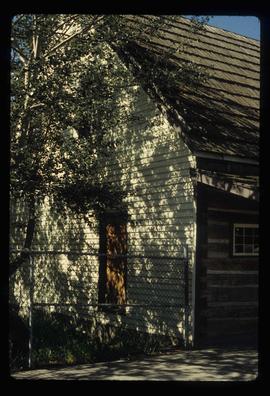Image depicts a view of the property at 153 Mile House, near Quesnel, B.C.
Photograph depicts a group of men and dogs standing outdoors in the sunshine.
Image depicts a basalt landform somewhere in or near Quesnel, B.C.
Subseries contains material collected and created by Kent Sedgwick for research on various areas in British Columbia and Alberta. Includes written notes by Kent Sedgwick, pamphlets, and newspaper clippings relating to towns and settlements. These areas include Quesnel, Likely, the Yukon Telegraph Trail, Barkerville, Wells, the Cariboo region, Fort Alexandria, Soda Creek, the Chilcotin region, Jasper, the Rocky Mountains, Mackenzie, Tumbler Ridge, the Peace River region, Fort St. James, the Omineca region, Kitimat, Lethbridge, the Bulkley Valley, and Fort Mcleod. These files cover a variety of topics including Chinese people in British Columbia, land settlement, tourism, and historic information on the regions.
Photograph depicts a caboose that carried Expo 86 (Vancouver) markings.
Photograph depicts a snow-covered forest clearing with six structures and a truck. Buildings have been numbered 1-8 with pen. Original handwritten annotations on verso of photograph are signed by Tom Marsh. Photograph is taped to paper. Typed annotation on recto of paper reads: “1. Bridge over creek. 2. Blacksmith shop. 3. Powerhouse. 4. Headframe over 200’ shaft. 5. Office 6. Water tanks from powerhouse. 7. Bunkhouse. 8. Truck. 9. Cookhouse behind #6 cannot be seen. We were always able to find the cookhouse even though hidden in this picture. Taken about 1935 by Russell Ross, supt. Quesnel Quarts Mine. Tom Marsh, Box 156, Squamish B. C.”
Photograph depicts Bob standing to right of house, holding an eagle by the wings. A very young Alan stands beside him, and younger brother Fred in front. Short wood fence crosses midground, trees in background. Typed annotation on recto of photograph: "Quesnel B.C. 1936 Northern B.C. Eagle shot at Dragon Lake, B.C. 7 ft. 6 in spread. Mounted by Jack Lestin, Prince George,"
Item consists of typed transcript of interview with Ivor Guest discussing his early memories of Prince George as a river man and logging. Includes discussion of Cataline, and Quaw family.
Harkins, BobItem consists of transcript and tape summary of interview with Tom Payne who discusses his life, emigration from England, service in World War I, and career as shoemaker in Quesnel. Also discusses his subsequent work at the Experimental Farm in Prince George
Harkins, BobPhotograph depicts Bridget Moran standing behind Mary John in unknown room. Unidentified woman semi-visible on far right (see item 2008.3.1.19.2). Accompanying photo caption: "Caribou College, Quesnel, March /92".
Photograph depicts Mary John and Bridget Moran holding paper cups in kitchen area, lockers visible through door in background (Moran on right). Accompanying photo caption: "Caribou College, Quesnel, March /92".
Photograph depicts Bridget Moran standing between Mary John (on left) and unidentified woman. Accompanying photo caption: "Caribou College, Quesnel, March /92".
Street view photograph looking down Carson Avenue at the Front St. intersection in Quesnel, BC. Several identified businesses line the gravel avenue on the right; however Cowan's Hardware store is visible at the intersection on the left. Printed annotation on recto reads: "Carson Ave., Quesnel, B.C. 1930 Looking East."
Image depicts the Cottonwood House Historic Site along Barkerville Highway, east of Quesnel, B.C. A sign posted by the fence reads: "For over half a century the Boyd family operated this haven for man and beast. Here weary travellers found lodging, food, and drink. Here fresh horses were hitched to stage-coaches and miners bought supplies. This historic road-house, built in 1864, stood as an oasis of civilization on the frontier of a rich new land."
Image depicts the picnic site of the Cottonwood House Historic Site, located on the Barkerville Highway, east of Quesnel, B.C.
Photograph depicts men standing near three covered wagons pulled by team of horses on street. Buildings line the street on left behind trees with protective structures built around their trunks. A windmill stands near small building and woodpiles in background on right. Trees on hill are visible in distance. Handwritten annotation on recto of photograph: "Quesnel".
Image depicts the interior of a barn at a dairy farm located somewhere near Quesnel, B.C. Numerous unknown individuals are present.
Image depicts numerous pieces of machinery in the interior of a building at a dairy farm, located somewhere near Quesnel, B.C. Several unknown individuals are present.
Image depicts an aerial view of Diamond Island, near Quesnel, B.C.
Image depicts a farm on the west side of the Fraser, south of Quesnel, B.C.
Street view photograph taken at the intersection of Front Street and Carson Avenue. Several men are gathered at Cowan's Hardware store on the corner. Also visible in this photograph is the Cariboo Hotel (visible furthest to the left), and the British American Hotel which is partially visible behind the J.A. Fraser store. Printed annotation on recto reads: "On Front Street, Quesnel, B.C."
In 1936, Gordon Young Wyness was employed by Philip M. Monckton, a B.C. Land Surveyor. Between June 5 and October 8, Wyness joined Monckton and a group of others on a land survey expedition in northwestern BC. The survey crew travelled to various locations in the area including Telkwa, Hazelton, Burns Lake, Francoise Lake, Vanderhoof, Prince George, Quesnel, Lytton, and Hope. Wyness documented their journey in this photograph album. Based on the photographs, it appears that the crew led by Philip Monckton consisted of Jack Lee and Gordon Wyness; Mrs. Lavender Monckton (nee O'Hara) also accompanied the group.
In addition to the 50 photographs included in the album, this collection also includes five additional unique photographs that accompanied the album.
Wyness, Gordon YoungPhotograph depicts Gordon Wyness sitting on a historic boat, which he described as built ca. 1860 and could carry "7 Indians" and 5000 lbs of freight up the river. Located nearby is a telegraph cairn erected to commemorate the Collins Overland Telegraph lines that began in Quesnel in 1865. Until 1907, Quesnel was the terminus for the telegraph line. Behind Wyness is a replica of a Cornish water wheel that was originally located at Williams Creek in Barkerville. This location is now called Ceal Tingley Memorial Park-Heritage Corner and is located along Front Street in Quesnel, near the Fraser River Bridge. The cairn and water wheel still stand in this location, however the boat was removed around 1941.
According to additional information from Quesnel & District Museum & Archives, Wyness may have been provided with inaccurate information about the canoe depicted. The canoe believed to have been located at that spot was actually created in 1905 to pack out the Grand Trunk Preliminary Survey Team, which was led by J.M. Rolston.
Photograph depicts a cluster of log buildings with fences and corrals. A field in the foreground, trees and low hills in the distance. On the road from Quesnell to Fraser Lake 1911.
Photograph depicts three men standing and sitting on a porch deck in front of a log house, trees in the background.
Image depicts a pile of irrigation pipes on a dairy farm somewhere near Quesnel, B.C.
Collection consists of 140 photographs pertaining to the life and pursuits of James Joseph Claxton over the course of sixty years. Subject areas identified within this collection include: quartz and placer mining in the Cariboo; Kingcome Village; the Royal Irish Contabulary; Roderick's Jewelers, New Westminster; the "M.S. Columbia III"; Kwakiutl petrographs in Fort Rupert; totem poles at Alert Bay; and the Salmon Arm Boy Scouts of Canada group.
Claxton, James JosephItem is a 14 Nov. 1912 receipt of products purchased from John A. Fraser & Co., Ltd. of Quesnel, B.C., "dealers in general merchandise and lumber". The buyer was Tom Styner[?].
Typed caption glued to album page directly below photograph reads: "39. Leaving Quesnel for Fort Fraser." Photograph depicts an automobile parked in front of a hotel with a sign on its back end that reads: "From Vancouver to Fort Fraser". Photographer: Dominion Stock & Bond Corporation.
Photograph depicts a group of men standing near a building with the sign, "James Reid Ltd. General Merchants". There are a few fences and buildings in the background.
This file consists of 10 photographs pertaining to the Hixon Creek Cariboo Gold Company, and the Quesnel Quartz Mine; as well as two sheets of letterhead from the "Hixon Gold Recovery Ltd." a handwritten speech re: a mineral claim, and a hand drawn map and overlay pertaining to the Wellington and Highland (Belle or Lass) mineral claims.
Photograph depicts four men standing under balcony of hotel near other buildings on street. Trees line the street, with protective structures built around their trunks. It is speculated that one of these men may be Mr. A. K. Bourchier. Handwritten annotation on recto of photograph: "As you were".
Photograph depicts man (presumably A.H. Holland) with survey pole standing next to loaded pack horse.
File consists of an electronic oral history transcript documenting the life of Bea Dezell from approximately 189? to 2004. Interview conducted in May and June 2004 by Denise Torgerson and transcript prepared by Elaine Hauck, both of Prince George Oral History Group.
File contains slides depicting landforms at various locations.
Photograph location is unknown, but Davies stated it to be possibly somewhere north of Quesnel. A bridge is visible.
Photograph depicts a chip car #9581 loading at a sawmill on the northern outskirts of Quesnel.
Photograph depicts a down freight of 75 cars passing under the Quesnel to Barkerville road about 4 miles out of Quesnel.
Photograph taken at the Pacific Great Eastern depot in Quesnel.
File contains postcard photographs portraying life in various Northern BC Communities. Images depict buildings and streets, church structures, harbours and docks, and views of the shore from the water to name a few.
File consists of records created or collected by Kent Sedgwick relating to various community projects associated with river parks. Example projects included in the file are a proposed Carrier village at Hudson Bay Slough, a Cottonwood Island park, proposed commercial boat tours on the Nechako and Fraser River, and the Quesnel Paddlewheel Park. Includes a project proposal document by the Fort George Band entitled "Establishing a Permanent Carrier Village in Prince George" (1990); a 1991 meeting package of the Nechako and Fraser River Valleys Committee (regarding the Cottonwood Island property and development of the Heritage River Trails System); a 1991 memorandum entitled "Prince George River Runners - Proposed commercial boat tours on the Nechako and Fraser River"; a 1983 "Submission to Rivers Committee Public Hearings by Heritage Advisory Committee, City of Prince George" describing the various river-adjacent heritage sites in Prince George; and documentation from the Quesnel Paddlewheel Association.
Image depicts the Bohanon House in Quesnel, B.C.
Image depicts the Bohanon House in Quesnel, B.C.
Image depicts the Bohanon House in Quesnel, B.C.
Image depicts numerous unknown individuals at the Bohanon House in Quesnel, B.C.
Image possibly depicts the Fraser River from Highway 97 near Quesnel, B.C.
Image possibly depicts the Fraser River from Highway 97 near Quesnel, B.C.
Image depicts the Fraser River from Highway 97 near Quesnel, B.C.
Image depicts the Hudson Bay Store in Quesnel, B.C.
Image depicts the Hudson Bay store in Quesnel, B.C. It was built in 1859.
